The Active Cities project brings together 8 European cities to assess how they can increase the number of active mobility users and improve the quality of walking and cycling in urban areas. Throughout the project, partners have the opportunity to pilot street interventions to move from car-centric to people-centric streets and improve the integration of active modes in multimodal journeys in mobility hubs.
Although these pilots focus on the built environment and infrastructure, a crucial element to boost and improve active mobility is the involvement of key stakeholders. Organisers of pilots must understand who the stakeholders are, what needs they have, and inform them about in any intended changes.
In an earlier insight, we shared the initial learnings on stakeholder engagement from three of our Active Cities; Hamburg, Aarhus, and Bergen.
In this article, we will explore the work being carried out by a some more of our Active Cities, learning how they are placing stakeholder engagement at the forefront of their activities to boost active mobility in their localities. This article features insights from Leeuwarden, Groningen, Lund, Mechelen, and Lille.
Leeuwarden
Leeuwarden is a city in the Dutch province of Friesland, and is known for its local delicacies and vibrant cultural scene, as well as its historic city centre.
Within the Active Cities project, the municipality of Leeuwarden is aiming to improve the walkability from the Snekertrekweg, a key waterside boulevard, to the inner city and railway station for the benefit of the area’s new residents.
The municipality has recognised the importance of engaging citizens throughout this process, reflecting that as the end users of this development, their pleasurable walking experience is the end goal of the pilot. As such, they play an important role in determining the success and feasibility of the pilot.
In order to ensure that local residents do remain involved, Leeuwarden will conduct street interviews using the Walk21 app, collecting insights prior and after the implementation of the pilot. The interviews, targeting local entrepreneurs, residents and passengers, will allow Leeuwarden to measure the success of the activities and understand the opinions of local stakeholders regarding the improved walkability of the area.
With some exciting developments ahead, we look forward to seeing the impact of this pilot on the walkability in this area of the city!
Groningen
Groningen is another city in the Netherlands, famous for the University of Groningen and a rich history spanning more than 1000 years.
Within the Active Cities project, the objective of Groningen’s pilot is to support walking in a green, healthy and safe environment to and from a shopping centre (Paddepoel) within the city by transforming traffic space into living space.
To ensure the successful implementation of this pilot, Groningen has recognised the importance and requirement of involving citizens throughout the process. Citizens know their neighbourhood best as the daily users of the public space around the shopping centre. They are also the suppliers of location-specific knowledge and co-creators in the transformation of space. By envisioning the future design in which living quality is key, Groningen hopes to encourage citizens to support future decisions towards the redesign of their streets.
The city has taken various measures to involve citizens in the process of the pilot implementation and ensure their opinions are considered throughout. Groningen is involving citizens through:
- Joint walks in the neighbourhood, asking locals to point out what matters to them.
- Discussion sessions on how to improve the pedestrian network by making use of maps.
- Making use of the walkability app.
- Designing the tactical urbanism project together with citizens.
- Discussing future designs together through the use of VR.
So far, all plans have been discussed with representatives of the citizens and entrepreneurs associated with the shopping mall.
Despite the plans to transform the area into a haven for active movement, the process has proved challenging thus far, partly due to the high complexity caused by various projects running concurrently in the area. Furthermore, citizens are more interested in physical realisations of previous shared ideas, instead of new research or planning. Nevertheless, we are looking forward to seeing the impacts of the pilot in the promotion of active mobility in this area of Groningen!
Lund
The next Active City with a pilot to share is Lund. Lund is a city in the province of Scania in Southern Sweden. The city is known for its prestigious university and striking architecture, while within the Active Cities project they are exploring what the concept of pedestrian zones means in different contexts, and how people can be encouraged to walk more.
Lund’s pilot will consider various zones of the city, including a typical Swedish residential area built in the 60s, the city centre (an old medieval area with limited space), and the central zone of one of the smaller villages within the municipality.
The Lund team recognises the importance of engaging citizens to influence decisions around the implementation of the pilot. Involving citizens in the process allows Lund to understand the user experience and perception, as well as opinions on the interventions. By involving local stakeholders, in this case made up of different departments of the municipality, politicians, residents, and all users of the city, as well as shop and restaurant owners, the team can increase their knowledge on what can be considered pedestrian-friendly and what encourages people to walk more.
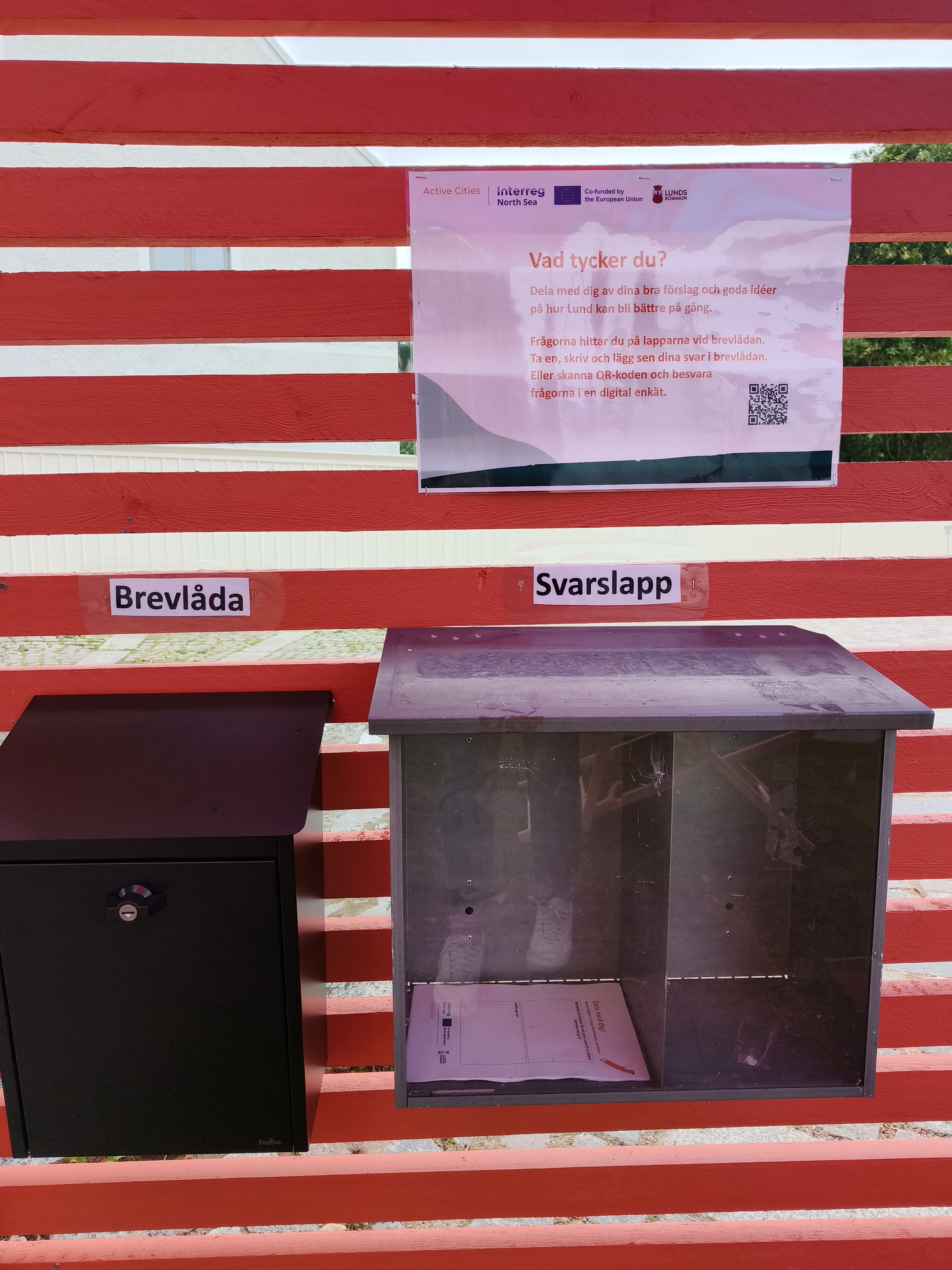
A postbox for Lund residents to submit their opinions and views on active mobility.
So far, these stakeholders have been involved through surveys and walking interviews using the walkability app. There are also plans to conduct some focus group sessions, which will be targeted more towards a specific group of pedestrians. Lund hopes for more involvement from end users, especially from residential areas, as this group is making use of the area on a daily basis and can fill an important current knowledge gap.
When the city introduced the first pedestrian street in the Spring earlier this year, they, together with the Citysamverkan (a collaborative organisation between three parties; the shops, property owners, and the city of Lund) invited business owners (shops and restaurants) from the surrounding streets to a morning seminar to talk about the new street regulation. This initiative provided an opportunity for them to voice their concerns and ask questions about how the new regulation affects them.
During the walk along interviews on one of the redesigned intervention streets, very little negative feedback was received, but sharp conclusions on attitudes were difficult to draw. In the morning seminar with business owners from the area surrounding the new pedestrian street, all feedback was positive, with no negative reactions to the initiative. Local politicians have also been consulted throughout the process so far, and were initially very positive, before becoming slightly more reserved.
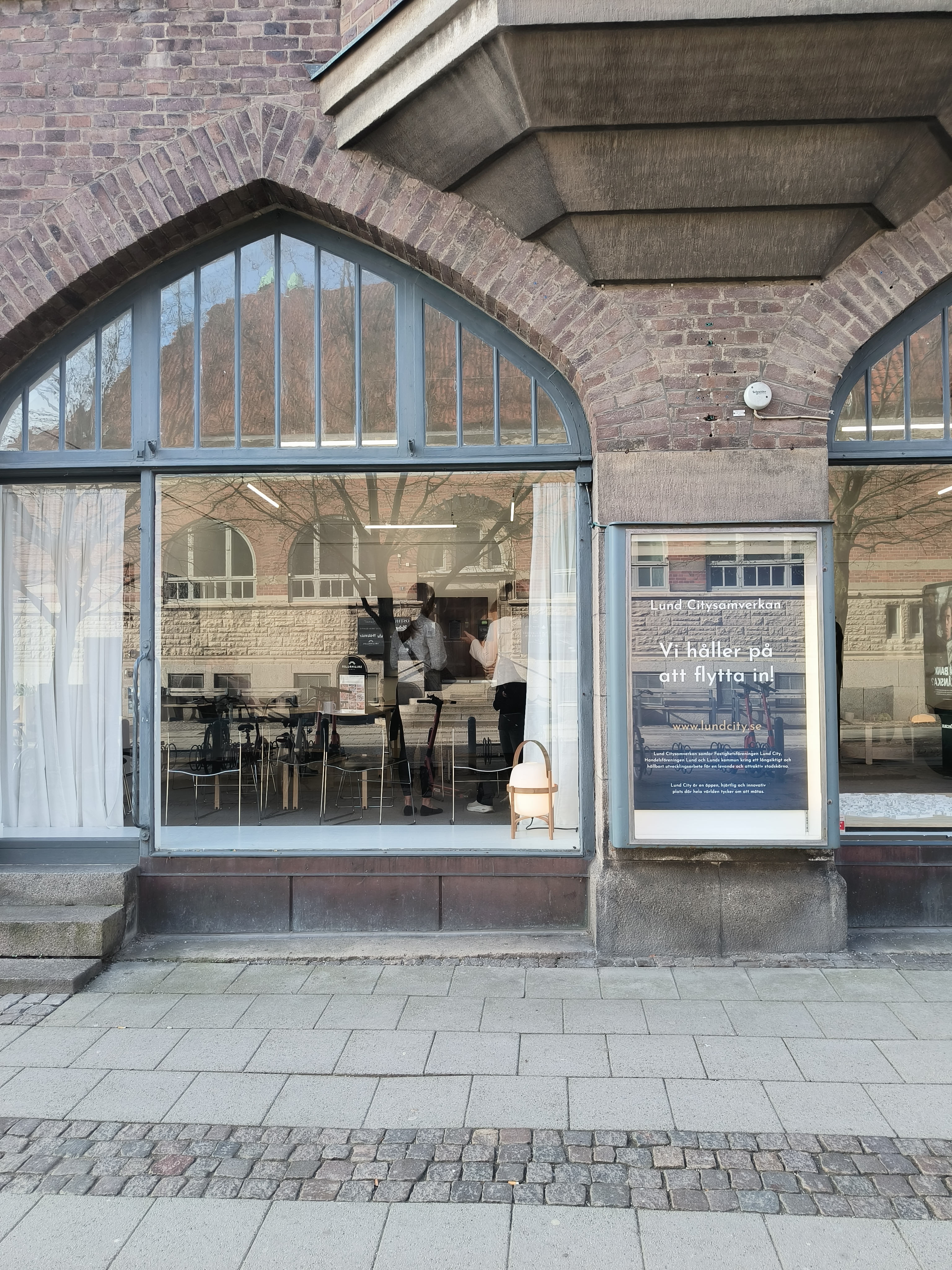
The setting for the morning seminar in Lund
Despite the mixed reactions to the interventions, Lund will continue to involve local stakeholders in the implementation of the pilots, with further plans to reach out to business owners and invite them for dialogue talks in the coming weeks.
Reflecting on the experience of involving stakeholders in Lund’s activities, Malin Bogren commented:
Through the pilot, we can test different measures in the physical environment and see how they affect pedestrians. Through dialogue and involvement, we really get to know more about what Lund residents, visitors and stakeholders think about the measures so that we can learn more about the effects and continue to develop our efforts for pedestrians in the physical environment.
Mechelen
Another active city to present its pilot in this article is Mechelen. Mechelen is a city in the province of Antwerp in Flanders, Belgium, known for its historical importance in religion and culture during the Renaissance period.
Within the Active Cities project, the Mechelen pilot involves installing 8 bicycle hubs at busy locations across the city. These hubs are strategically placed to enhance the existing cycling infrastructure without obstructing public spaces, aiming to address the high demand at bicycle repair workshops.
For Mechelen, involving citizens and stakeholders such as university researchers, students, activists, and NGOs can provide fresh insights for the project and help assess the usefulness of the pilot activities. Their contributions not only add diverse perspectives, but also enrich the project with their unique knowledge and expertise. In addition, this approach encourages a sense of ownership among the involved parties, fostering a more inclusive and participatory project development process.
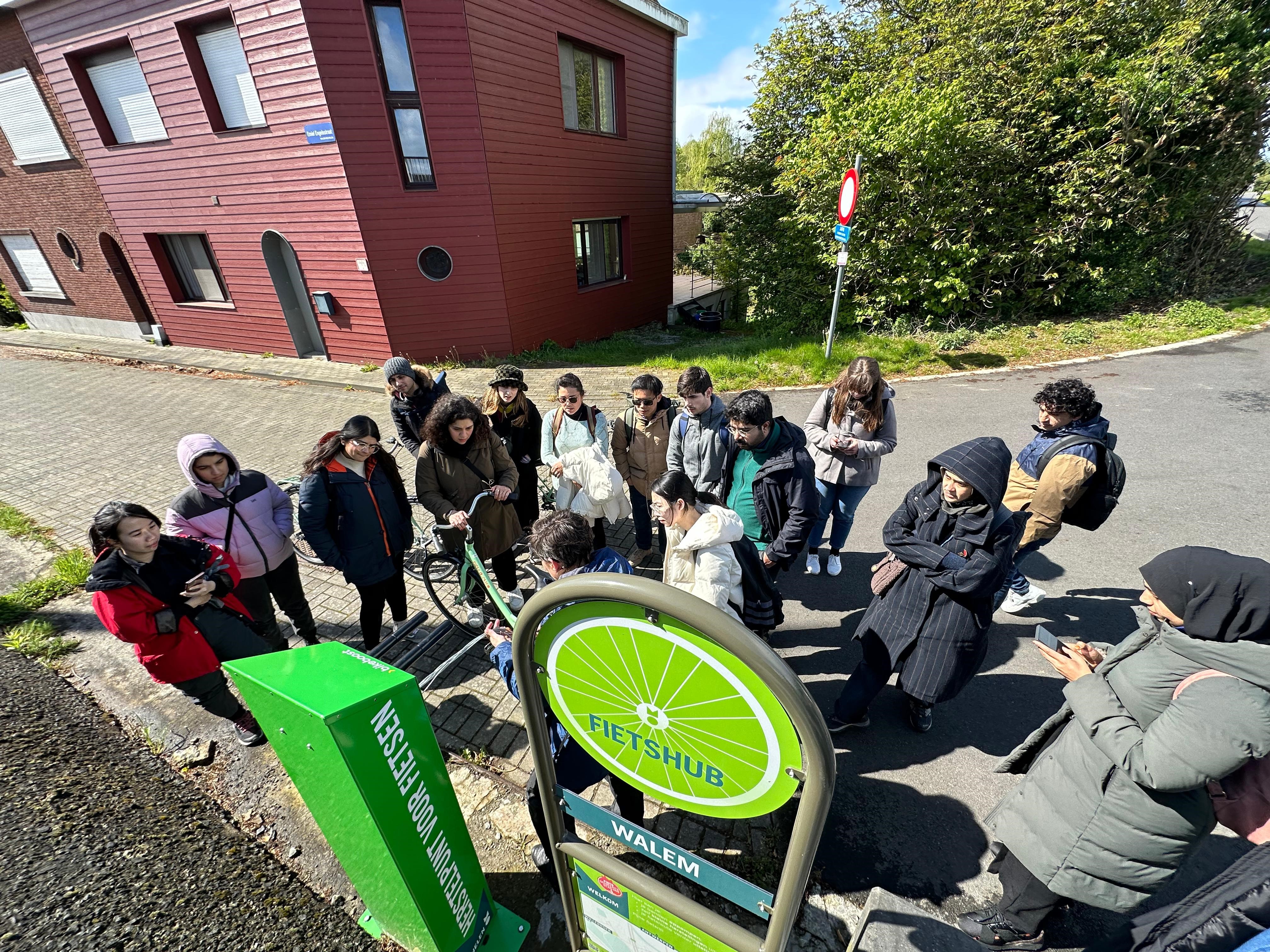
Active Cities fieldwork in Mechelen in the form of a bike tour with students from KU Leuven.
At this stage of the project, Mechelen sought to collaborate with Active Cities knowledge partners Aalborg and KU Leuven universities in order to engage with inhabitants of various ages, backgrounds, and cycling habits.
For KU Leuven, and coordinators Prof Pieter Van den Broeck and Dr Carine Assaf, the objective is to reconfigure streets for active mobility. To assist with this, they involved students from the Institutional Aspects of Spatial Planning (IASP) course and the International Module for Strategic Spatial Development Planning (IMSDP) programme in an action research workshop emphasising that “cycling is more than just a two-wheel activity.” Throughout the workshop, students examined the role of cycling hubs in 1.) promoting active mobility by increasing accessibility, 2.) enhancing the experience of cyclists, and 3.) contributing to the green transition.
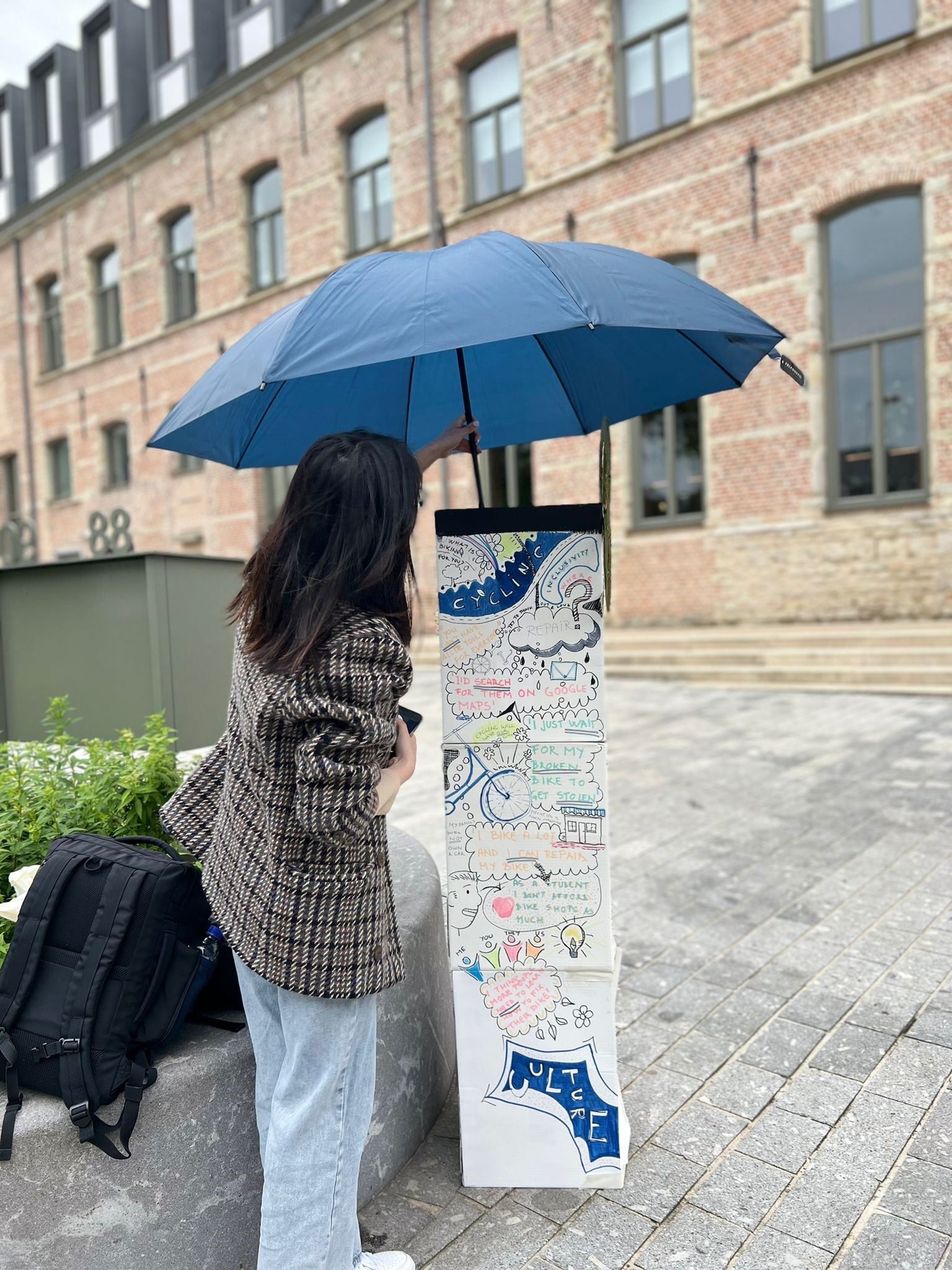
Pictures from Mechelen’s action research day, featuring interviews with local residents.
Through street interviews, the team aimed to understand their use of cycling repair hubs and knowledge of bike repairs. As a result, participants and inhabitants of Mechelen became stakeholders in this Active Cities pilot. Additionally, other stakeholders from Mechelen’s public library, Fietsatelier, Fietserbond, Bikeboost were also interviewed to gain further insights on the project.
Through the involvement of important stakeholders, it became clear that the cycling infrastructure is already well established in the city of Mechelen, and the spatial and social aspects of cycling hubs play an important role in supporting the cycling culture. For instance, based on interviews and fieldwork, the cycling hubs are primarily used as emergency tools. Therefore, Mechelen has identified a need to increase their presence across the city.
Lille
The final active city to present its pilot is Lille. As part of their sustainable mobility ambition, the city of Lille in Northern France has opened a Sustainable Mobility House (SMH) to transform the city’s transport habits, reduce individual car use, and increase awareness of sustainable transport options.
The principle target audience for the SMH are the citizens of Lille, who can use the facility as a a mobility awareness-spreading centre and receive advice on mobility solutions to match their needs. The city is aiming to help local people change the way they get around the city to go to work, take their children to school, and make other common journeys.
For Lille to run their activities appropriately and effectively, stakeholder engagement is important. The main stakeholders involved include citizens, tourists, students, elementary school students, small companies, and entrepreneurs. The SMH also works closely with local associations and institutions to promote sustainable mobility and organise public events.
Within the facility, strategically located between major train stations and the city centre, local stakeholders can find the bike learning track, one of the most significant aspects of the SMH. ADAV, an expert bike organisation, uses the track for their free weekly bike lessons, helping locals to learn how to ride a bike or increase their confidence around traffic. Furthermore, the facility collaborates each month with local bike repair associations to host a second-hand bike market.
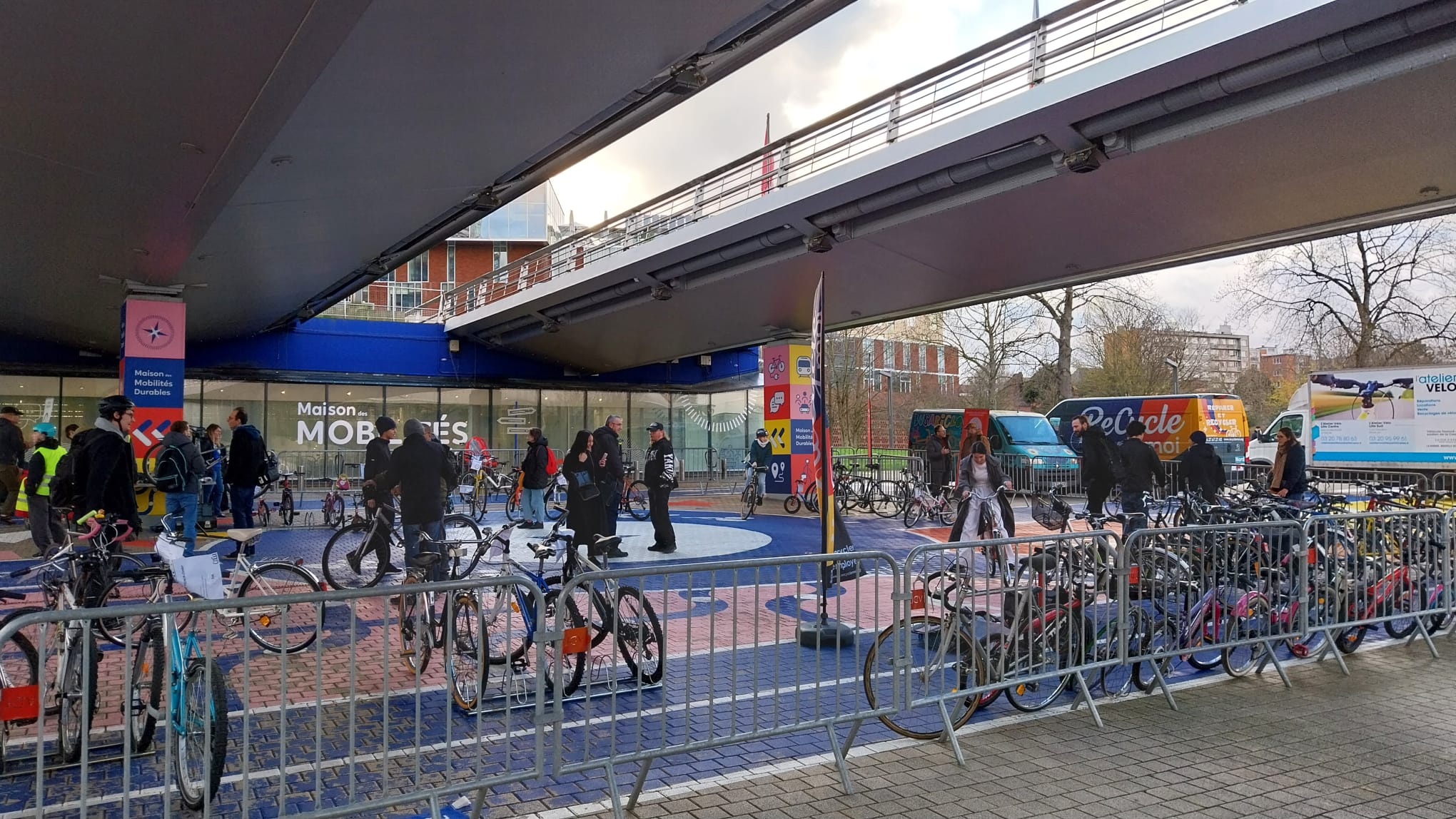
The monthly bike market at the Sustainable Mobilty House in Lille
Another innovative way to promote stakeholder engagement and involvement is the creation of a participative panel, on which visitors can write down their ideas for the SMH and and city, or share their favourite trip without a car within the region. This allows the organisation to draw inspiration, while creating new missions or events for the SMH and local stakeholders.
Generally, visitors to the SMH consider it a great initiative and are excited to see what comes next for the facility. The monthly bike market is becoming increasingly popular and important, and is the only regular bike market in the area. The collaboration with citizen associations is working well, and the team behind the Sustainable Mobility House plans to continue using their partnership to organise public events moving forward while emphasising collaborations with local universities and primary schools.
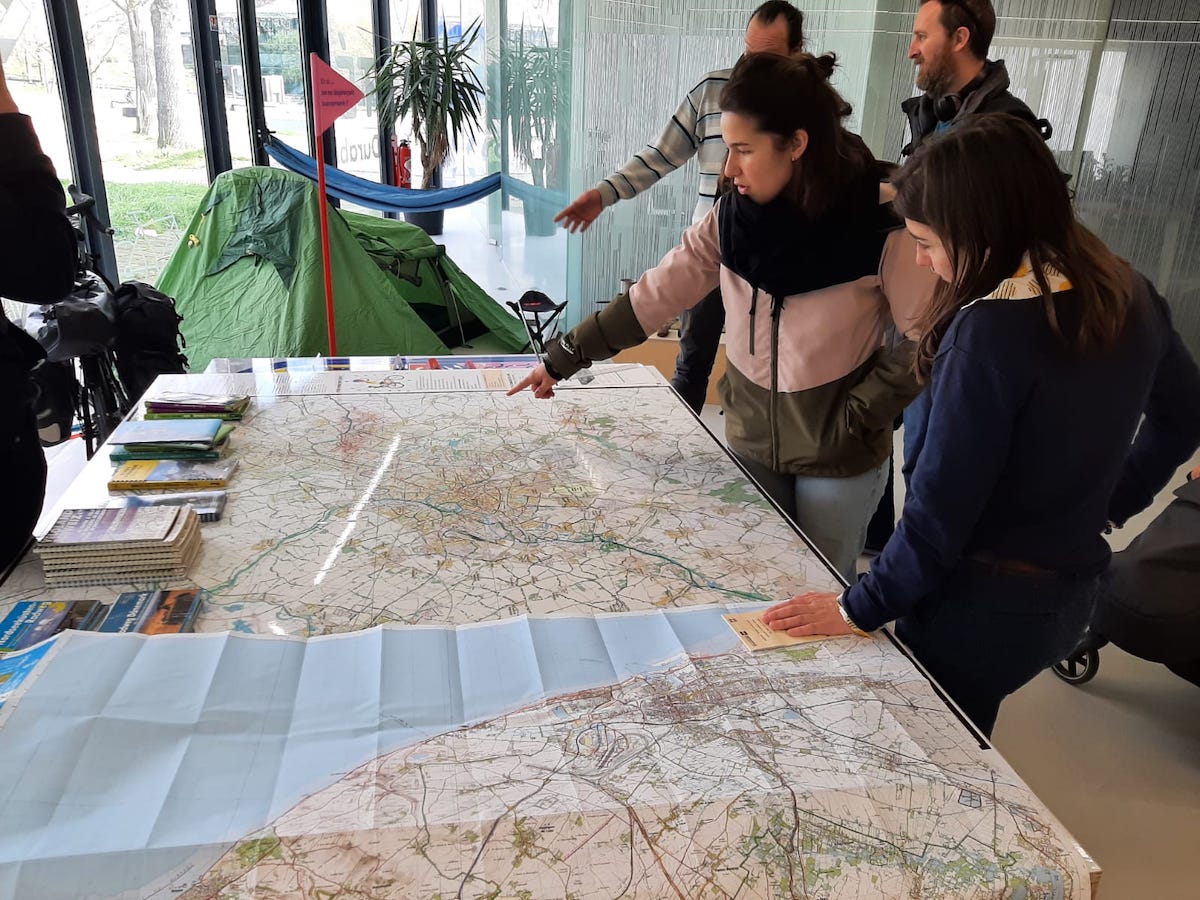
Attendees at a traveller meeting at the Sustainable Mobility House in Lille. Here, people can share their experiences of travelling by bike, foot, or train to inspire future visitors.
